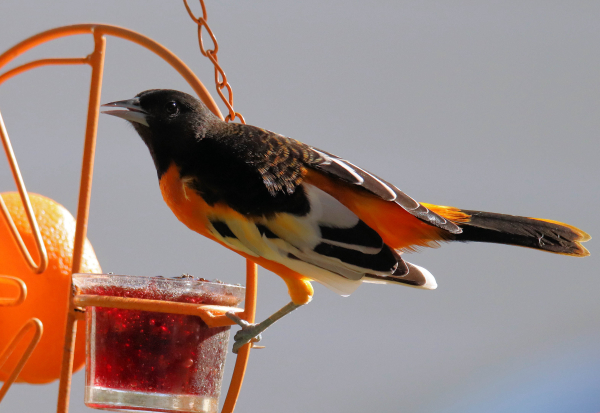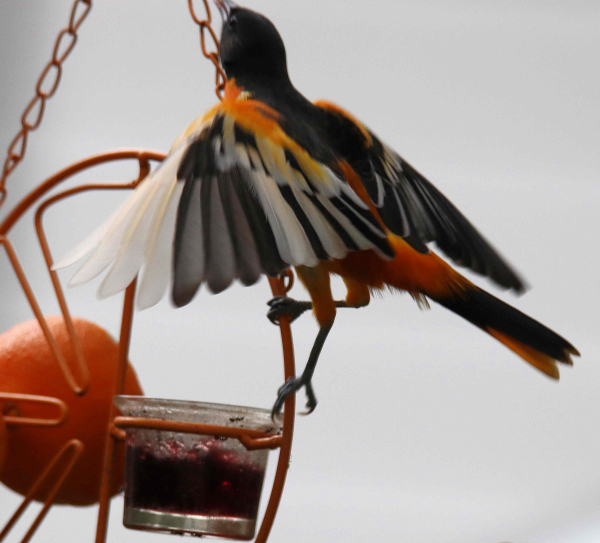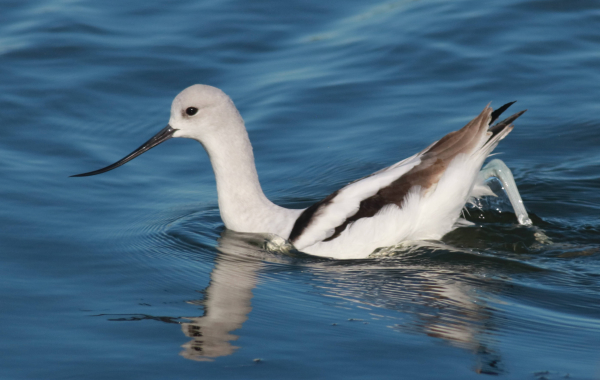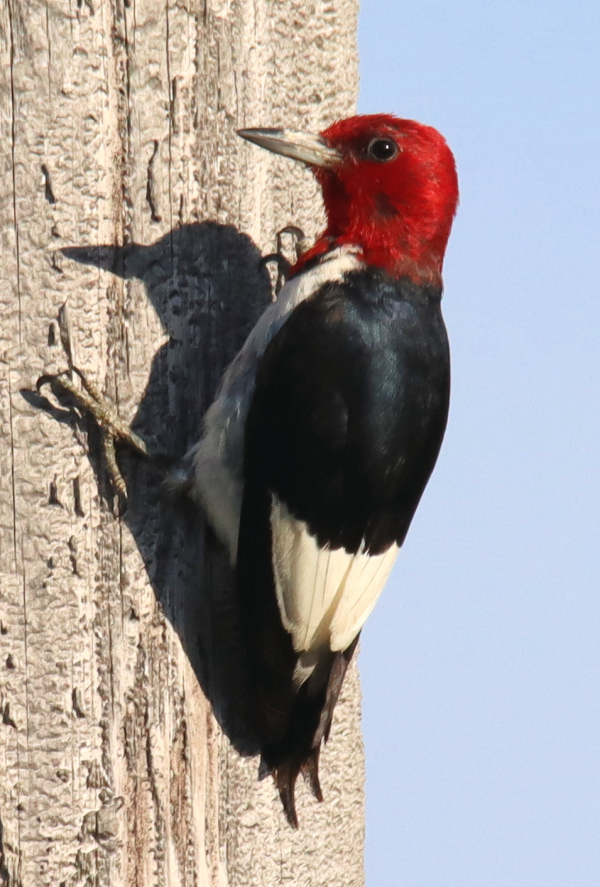
A documentary photo of an adult male Baltimore Oriole with several white wing feathers that has frequented Paul’s jelly feeder.

This chance photo of the partial albino (leucistic) Baltimore Oriole as it was taking flight shows the individual white feathers mixed among normally colored plumage on its left wing.

Large flocks of American Avocets in basic plumage were foraging in the shallows south of McKenzie, some wading and some swimming.

Initially thought to be a molting adult male, upon closer inspection this young Wood Duck still shows downy feathers on its nape and elsewhere.

Red-headed Woodpeckers in 10 territories provided enjoyable observations and a few photos during the past couple weeks. This image shows an interesting mirrored shadow of the adult.
|
WoW! At first I dismissed it as part of an ongoing molt, but when I viewed the adult male Baltimore Oriole at my jelly feeder with binoculars, I realized that many of the feathers on its left wing were white. As I studied the white feathers that mixed from the top to bottom of the wing with normally colored feathers, including some white outer primaries, some secondaries, a tertiary, a scapular feather, and many coverts. How exciting to have such a rare and unique bird stop by my feeding station! What great luck! It’s certainly my first oriole with some white feathers, my first white-winged oriole – ha.
This partial-albino or leucistic oriole appeared Friday among at least 6 Baltimore Orioles that visited my feeder, including a normally colored adult male and 3 fledglings that have been pretty regular, plus a yearling female. Combined with 3 new Ruby-throated Hummingbirds, the influx of feeder birds indicated some were short-stopped by what turned out to be a soaking 4 hour rainfall that afternoon. The precipitation didn’t seem to reduce their feeder visits, and it may have increased them.
Of course I wanted to get a photo of the unusual Baltimore Oriole, but the rain and overcast sky didn’t permit much of a photo – even if I could have managed a documentary low-light, blurry photo of the wary partial-albino. I crossed my fingers and hoped for a chance to photograph the unique oriole Saturday with full sunshine. Indeed, sunny it was, and I waited impatiently to see if the leuco male was still in the area. About 1pm it arrived, caught me off guard as I was writing, but I had my camera within reach, grabbed it and focused on the oriole; but a split second before I pressed the shutter, it flew off, leaving me with a photo of my jelly and orange feeder. But the good news was that the oriole was still in the area, and still hooked on grape jelly. Patience … but I didn’t see the rare oriole again that afternoon – hmm.
During some quiet moments Sunday, in between writing and editing articles, 24 hours after I last observed the white-winged oriole: I was casually sitting, resting, but with my camera lying across my lap; when suddenly, there it was. It landed on the shepherd’s crook above my oriole feeder and I began taking photos, even though it was only showing its normally plumaged side. As it worked its way down the feeder to the jelly jar, the oriole flipped around to show its partly white wing, which prompted a flurry of photos, but alas the now overcast sky provided little light to properly document the oriole’s white feathers. However, during the split second that it spread its wings as it took flight I took the last photo in the series, and that’s the one that clearly showed each feather in that partly white wing – hooray!
The photo of the spread wing clearly shows the 4 outer primary wing feathers are white, along with at least 3 secondaries and 1 tertiary, along with 1 white scapular feather, and many covert feathers on the upper wing, some of which are white, while others are partly white. It’s safe to say that there is no other oriole with these distinctive albino white feathers.
Just 40 minutes later, he was back, providing similar documentary photo ops, but this time my camera was next to my chair as I was writing about the first experience. Even so, I seamlessly reached for the camera, focused and took another flurry of photos, still in poor light, but with the male holding its partly white wing slightly more open. I waited for another flight foto, but missed it; however, the oriole perched on the top of the shepherd’s crook for a moment, providing a photo that permitted a comparison of its 2 wings from behind, showing the extent of white feathering on the left wing compared to the right from a different angle. The best 3 documentary photos were not great quality, except they do provide a good indication of how unique this Baltimore Oriole really is.
Also at my feeding station, hummingbirds continue to visit my nectar feeder regularly, and I was glad to see at least 3 Friday, but had the impression there was just 1 in the area Saturday and Sunday, but each day I expect a little swarm of hummers to appear … patience.
Rural Bismarck
I was excited to see a big change since my last check on the McKenzie wetlands 2 weeks before, with a new assemblage of about 210 American Avocets split into 3 flocks of 80, 30, and 100 feeding in the shallows of the big pool on the southwest side of the wetlands. Mixed among them were about 50 Willets, a few Marbled Godwits, some Long-billed Dowitchers – but wait! On the edge of the flock of loafing Willets and dowitchers were 2 shorebirds I rarely get to see in these parts, 2 American Golden Plovers! These Arctic-nesting birds were making a stopover in central North Dakota during their migration to wintering areas in northeast Argentina or southeast Brazil. I was excited after not seeing one of these impressive plovers for about 3 years, and that was during spring migration.
This area of McKenzie Slough is a prime late summer staging area for shorebirds during late summer when water conditions are right, just as it’s a staging area for molting ducks during mid-summer. There were also several White-faced Ibis on the edge of the shorebird shallows, and in other marshy areas with emergent plants. On that side of the wetlands there was also an group of 8 Great Blue Herons, and Black Terns and Common Terns, and Ring-billed Gulls were scattered through the area, along with some ducks and Giant Canada Geese.
Closer to Bismarck, I checked on Dogtown Marsh and found a scattering of Wilson’s Phalaropes feeding in open water, plus a few Lesser Yellowlegs and Spotted Sandpipers along the shores. There were the usual late season ducks, many of which were adult-looking broods of Mallards and Blue-winged Teal I observed earlier in the year as young ducklings. I stopped to photograph a couple molting Wood Ducks, but upon a closer look at my photos that night, I realized they were actually young males with some downy feathers on their nape.
A couple hours later, in between errands in Bismarck, I returned to Dogtown to see if I could get some photos at the peak of evening sunlight. At first it didn’t look very promising, but when I least expected it, a chance sighting of a couple young Orchard Orioles at the edge of the marsh led to an excellent photo session that I describe and illustrate in this issue’s Bird Photography feature.
Weekend Birding Drives
Beautiful weather Saturday pressed me to take an extended birding drive to update migration observations as well as the progress of fledging Red-headed Woodpeckers at the 8 active territories I found last week. The woodpeckers provided some nice surprises, with a new fledgling at the southern-most nesting territory along with an adult. Then, after checking the location with the brood of 4 fledglings no less than 5 times during the past 7 days without seeing a fledgling or either of the 2 adults – suddenly a fledgling flew into the open! I positioned at a better vantage point, and 3 fledglings quickly flew into view, one by one, then slipped into the tangle of trees adjacent to the areas I have watched them hawking insects on the wing the previous Saturday. I waited a while, then pressed on to check 3 other territories, finding another fledgling at the territory just north of my friend Jason’s farmstead, and a male hawking insects at the northern-most territory.
The northern Red-head adult provided some photo opportunities, as did a Great Egret that was intent on catching very small fish in a shallow wetland bay. I spent a bit more time photographing a foraging flock of about 20 Black Terns that included a high percentage of fledglings as they repeatedly flew into the wind on the edge of a big lake where they made periodic dives to catch very small fish. During most dives, they submerged their entire body below water, with only their wings pointing out of the water, then took flight again – they are such strong and nimble fliers! I also found 3 Belted Kingfishers within a square mile, each overlooking its own marsh, and there were a few obvious changes among the avifauna that I wanted to verify during a second weekend drive.
Having covered the 8 woodpecker territories Saturday, on Sunday I just checked on 2, but I accidentally found a new adult and fledgling on a new territory about midway between 2 others. It turns out the territories are each about 2 miles apart, and inspired a bit, I checked a new area to the west and found a 10th territory with an adult and fledgling on hand – and it also was 2 miles from the nearest known nesting territory.
As noted above, there have been a few obvious changes among some of the summer birds; that is, several species appear to have migrated out of the area – notably, Upland Sandpipers, Common Nighthawks, Bobolinks, Dickcissels, and Western Kingbirds. There are still many Eastern Kingbirds; in fact, over the past week or so their numbers were obviously increasing, but Sunday there were loose flocks of Easterns covering several square miles with birds separated by 20 to 50 feet – I’ve never seen so many, nor have I observed anything remotely like a flock of Eastern Kingbirds. When will an exodus follow? There continue to be large flocks of Tree Swallows, Mourning Doves, and Killdeer too.
September is a great period of transition from summer to fall in this region, at this latitude; and while it’s been a great summer, it’s been too short – as always. Up here nature tends to change on an almost weekly basis. Every day I look forward to new birds, new insights into birds and how they fit into the seasons and surrounding habitats. Be aware, keep your eyes focused, and enjoy the birds that cross your path or that you seek out – the next exciting observation may be out your window, or down the road, but always make the most of it and learn from each birding experience. I have learned over the decades that each season, and each species, is revealing and rewarding.
Article and photos by Paul Konrad
Share your bird sightings and photographs at editorstbw2@gmail.com